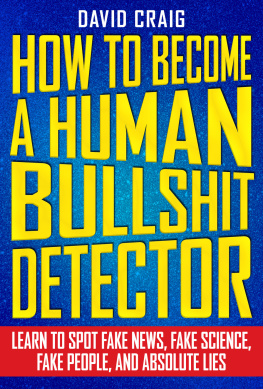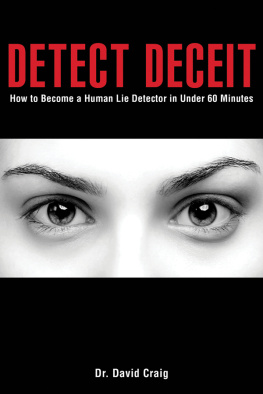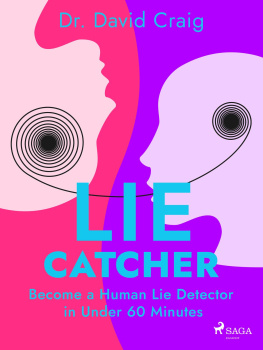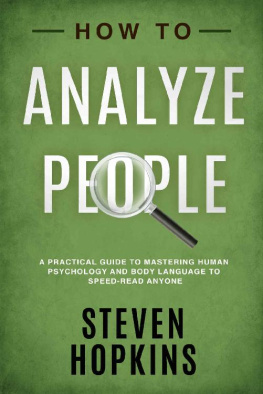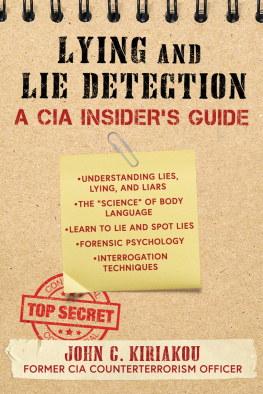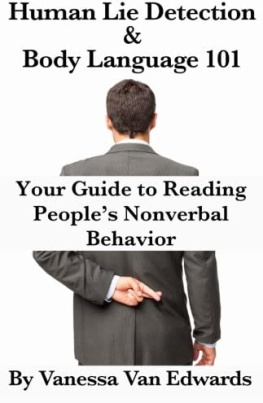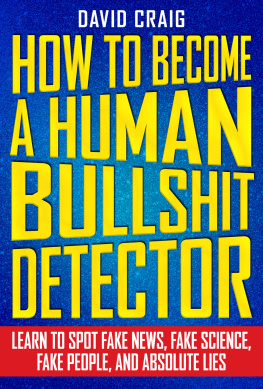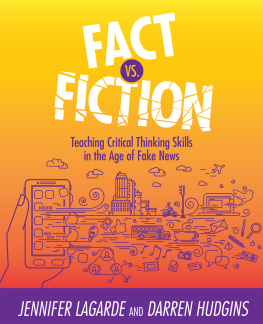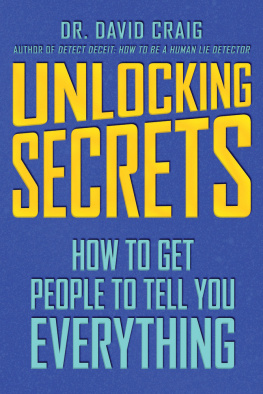Copyright 2012, 2017 by David Craig
Originally published as Lie Catcher by Big Sky Publishing Australia
All Rights Reserved. No part of this book may be reproduced in any manner without the express written consent of the publisher, except in the case of brief excerpts in critical reviews or articles. All inquiries should be addressed to Racehorse Publishing, 307 West 36th Street, 11th Floor, New York, NY 10018.
Racehorse Publishing books may be purchased in bulk at special discounts for sales promotion, corporate gifts, fund-raising, or educational purposes. Special editions can also be created to specifications. For details, contact the Special Sales Department, Skyhorse Publishing, 307 West 36th Street, 11th Floor, New York, NY 10018 or .
Racehorse Publishing is a pending trademark of Skyhorse Publishing, Inc., a Delaware corporation.
Visit our website at www.skyhorsepublishing.com.
10 9 8 7 6 5 4 3 2 1
Library of Congress Cataloging-in-Publication Data is available on file.
Cover design by Brian Peterson
ISBN: 978-1-63158-225-7
E-Book ISBN: 978-1-63158-226-4
Previous ISBN: 978-1-61608-646-6
Caveat: The views and comments expressed in this book are solely the authors. The author does not represent any government agency, any commercial company or private body. The techniques contained in this book are utilized by lie-detection professionals around the world and when correctly applied, will improve the accuracy of lie detection in most people. However, no technique in lie detection is 100 percent accurate, and caution should be exercised before reaching a conclusion that a person has lied.
Printed in the United States of America
ACKNOWLEDGMENTS
I would like to thank my wife and four children for their support while I was committed to this project.
I would also like to acknowledge Denny Neave of Big Sky Publishing for his faith and commitment, and last but not least, Diane Evans, who provided insight and worked tirelessly to keep all the moving parts oiled and on time!
TABLE OF CONTENTS
10 percent of the authors profits from the sale of this book will be donated to the Royal Childrens Hospital and the National Police Memorial of Australia.
INTRODUCTION
You were most likely attracted to this book because you are intrigued by the concept of knowing whether or not somone is telling you the truth, or you have unknowingly been lied to in the past and want to protect yourself against deception in the future. This book will assist you with both.
When I first began researching the subject of lie detection years ago, I realized that there were many high-level academic papers and textbooks on the subject, but no credible and easy-to-read guides offering knowledge and skills that could be put straight into practiceso I decided to write one.
If you are looking for a psychological edge when cutting a business deal, negotiating an outcome, interacting with people, or even making a purchase, then this book is for you. Lie detection does not have to be a sinister practice. You will find there are some fun and interesting exercises within these pages. Challenge your friends and familycan they get away with lying to you?
In addition to having over twenty years of criminological experience and research focused on deception and deception detection in covert operations, I have spent many hundreds of hours researching the theoretical work of some of the worlds finest academics on this subject. The combination of theoretical knowledge and practical experience has enabled me to consolidate all the relevant information into a very practical book, which will quickly set you on the path to becoming a human lie detector. Studies have shown that with training and practice most people can rapidly increase their success at detecting lies. This book will do this for you.
If your time is limited and you just want to get started, I have designed this book so you can bypass Part One: Understanding Lies and go straight to the practical section, Part Two: Detecting Lies. If you decide to start with the practical section, I recommend that, as you are practicing what you have read in Part Two , you make the time to read Part One , as it will provide you with a greater understanding of deception.
Knowing the difference between when people lie to you and when they are telling the truth is a vital human skill for the twenty-first century. Regardless of your age, gender, or background, this book will equip you with tools you need to become an effective human bullshit detector. Happy hunting!
Part One
Understanding Lies
THE NATURE OF LYING
Mendacity, fib, untruth, falsehood, whopper, yarnIve even heard it politely referred to by an American presidential candidate as having misspoke. Im not sure thats even a wordperhaps it was a lie. Regardless of the title or the context within which it occurs, we all have an opinion on what a lie is, and there are a multitude of different descriptions for the act of lying. In my opinion, a lie is a physical act, verbal statement, or omission, deliberately designed to deceive another of the truth. For example, a person could lie physically, as a shoplifter does, projecting the physical impression to store security of an honest shopper, while secretly removing goods from the shelves. Verbally, a person may attempt to deceive another person by saying, or not saying, particular words. Both examples are designed to deceive another of the truth.
Most people would agree that lying is an act of dishonesty, and it is this negative connotation that leads most people, when asked, to say they very rarely lie. In almost all cases, this is incorrect. There have been many independent academic studies on the frequency of lying in society. Some have revealed that people lie as little as twice a day (only 730 times a year!), whereas more recent research shows on average people lie three times in every ten minutes of conversation. To most people these are surprising statistics, verging on unbelievable. This is understandable considering that one of the most offensive things a person can be called by another is a liar. The fact remains, however, that studies conducted across a variety of societal groups and cultures have revealed that while the frequency of lying may differ from study to study, lying is a universal and everyday event.
When people first hear this they disagreeand I admit that initially it sounds quite shocking. It is only through understanding the very nature of lying that these statistics make sense and it becomes easier to accept that lying is a very normal part of human interaction. Once you understand the nature of lying and can identify that someone has lied to you, you will be able to calculate the motivation behind why the person lied.
Broadly speaking there are two categories of lies: Self-Focused and Other-Focused. Self-Focused Lies are told to help the person telling the lie, whereas Other-Focused Lies are told to help another person. Well examine the Other-Focused Lies first, as these are usually innocuous and are rarely hurtful or threatening. On the other hand, Self-Focused Lies do have the very real potential to detrimentally affect the people to whom they are told. That being the case, after a short discussion on the nature of Other-Focused Lies, the remainder of the book will examine in detail Self-Focused Lies and how you can detect them.
Other-Focused Lies
Other-Focused Lies are, as the name suggests, lies that are focused upon another person. They are usually told with good intentions, and, in most cases, if the truth is discovered it is not overly hurtful to the person to whom the lie was told. These lies are sometimes referred to as white lies or good-will lies, and the motivation for telling them is to benefit or protect another person in some way.

